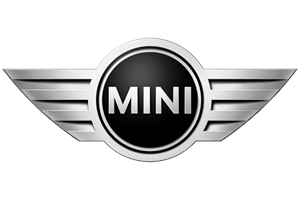A brief history of
Mini
Introduction
The car manufacturer Mini has made an important impact on the automotive world. In this article we will give a brief but detailed history of the Mini marque.
We will look at the origins of Mini looking at who, why, where and when Mini was founded. We'll look at the design of the iconic Mini logo and what are some the more significant Mini models.
We'll take a glance at what racing history the Mini has and who some of the most important people have been in the history of Mini over the years.
Who, where, when and why was
Mini founded?
Mini, a beloved car manufacturer known for its iconic compact vehicles, has a fascinating history that traces back to the mid-20th century. The brand's story begins in 1959 when the British Motor Corporation (BMC) introduced the original Mini, a revolutionary small car that would go on to leave a lasting impact on the automotive industry.
The Mini was the brainchild of Sir Alec Issigonis, a British-Greek engineer who aimed to design a compact, fuel-efficient vehicle that maximized interior space. With its innovative transverse engine layout and front-wheel drive, the Mini offered exceptional handling and agility despite its diminutive size. It quickly gained popularity in the UK and became an icon of British design and engineering.
The Mini's success prompted the establishment of the Mini brand as a standalone entity in 1969, with the formation of British Leyland Motor Corporation (BLMC). However, over the years, the ownership of the brand changed hands multiple times. In 1994, German automotive giant BMW acquired the Rover Group, which included the Mini brand. Under BMW's ownership, the Mini underwent a major redesign and relaunch in 2001, reintroducing the iconic small car to the world.
Today, Mini's headquarters are located in Munich, Germany, reflecting its ownership by BMW. The brand continues to embrace its heritage while incorporating modern design and technology into its lineup of vehicles. Mini's mission is to provide agile, stylish, and efficient cars that offer a unique driving experience and reflect the brand's British roots.
The Mini brand's enduring popularity can be attributed to its distinctive design, fun-to-drive nature, and the sense of personality it exudes. With its compact size, customizable options, and playful charm, Mini has attracted a dedicated fan base worldwide. The brand's vehicles, including the classic Mini Cooper, the Countryman crossover, and the Convertible, have become synonymous with individuality, style, and a touch of British flair.
Mini's success lies not only in its captivating design and driving dynamics but also in its ability to adapt to changing market demands. Over the years, the brand has expanded its lineup to include electric and hybrid models, showcasing its commitment to sustainability and innovation. The introduction of the Mini Electric in 2020 marked a significant step towards a greener future while maintaining the brand's core values of fun and excitement behind the wheel.
With its rich history and unwavering dedication to delivering a unique driving experience, Mini has solidified its place in the automotive world. The brand's ability to capture the essence of the original Mini while evolving with the times has allowed it to remain relevant and highly regarded by car enthusiasts around the globe. Whether it's zipping through city streets or embarking on an adventure, a Mini is more than just a car—it's a statement of style and a symbol of automotive innovation.
How did the
Mini logo originate?

How did the Mini logo originate?
The logo of Mini, the iconic car manufacturer, has gone through several iterations over the years, reflecting the brand's evolution and capturing its essence. The original Mini logo, introduced in 1959, featured a simple and elegant design. It showcased the brand name "Mini" written in lowercase letters with a thin, horizontal line underneath. This minimalist logo perfectly encapsulated the car's compact and understated character.
In 2001, when BMW re-launched the Mini brand, a new logo was introduced to represent the modern era of Mini. The updated logo retained the lowercase "mini" lettering but added a stylized winged emblem above the brand name. The wings symbolized the brand's forward-looking vision and the spirit of freedom and mobility. This logo emphasized the brand's connection to its British heritage and conveyed a sense of energy and dynamism.
In recent years, Mini has further refined its logo design. The current logo, introduced in 2015, maintains the familiar lowercase "mini" lettering but removes the winged emblem. Instead, the logo features a bold, three-dimensional representation of the word "MINI," with rounded corners and a sleek appearance. This logo reflects Mini's modern and contemporary image while retaining its distinctive identity.
The evolution of the Mini logo mirrors the brand's journey from a compact, fuel-efficient vehicle to a symbol of style, individuality, and driving fun. The changes in the logo design highlight the brand's commitment to innovation and staying relevant in the ever-changing automotive landscape.
What are some of the significant
Mini models?
Mini, the iconic car manufacturer, is known for its compact and stylish models that have captured the hearts of drivers around the world. While Mini is widely recognized for its small and efficient cars, the brand has also ventured into the realm of high-performance vehicles, offering exhilarating driving experiences. Let's explore some of the most significant performance models from each quarter of Mini's history.
In the 1960s, Mini introduced the Mini Cooper S, a sportier version of the classic Mini. With its more powerful engine, upgraded suspension, and improved brakes, the Mini Cooper S became a popular choice among racing enthusiasts and rally drivers. The car's nimble handling and impressive performance on the track made it a formidable competitor in various motorsport events.
As Mini entered the 1980s, it continued to uphold its reputation for producing fun and spirited cars. In 1986, Mini unveiled the Mini John Cooper Works, named after the legendary race car builder John Cooper. This high-performance variant featured a turbocharged engine, upgraded suspension, and aerodynamic enhancements. The Mini John Cooper Works embodied the essence of Mini's racing heritage and offered a thrilling driving experience on both the road and the track.
In the early 2000s, after BMW took over the Mini brand, the lineup expanded to include even more performance-oriented models. One notable addition was the Mini Cooper S Works GP, introduced in 2006. This limited-edition model boasted a more powerful engine, reduced weight, and enhanced aerodynamics. With its track-focused design and impressive performance figures, the Mini Cooper S Works GP pushed the boundaries of what a compact car could achieve in terms of speed and handling.
Continuing its commitment to performance, Mini introduced the John Cooper Works GP in the 2010s. This ultra-high-performance model featured a turbocharged engine producing exhilarating power, advanced suspension technology, and aerodynamic enhancements. With a limited production run, the Mini John Cooper Works GP showcased the brand's dedication to delivering uncompromising performance in a compact package.
Throughout its history, Mini has proven that small size doesn't mean sacrificing performance. From the classic Mini Cooper S to the modern John Cooper Works models, Mini has consistently pushed the boundaries of what is possible in terms of speed, agility, and driving enjoyment. These higher-performance variants have not only delighted Mini enthusiasts but have also solidified Mini's position as a brand that delivers fun, excitement, and a unique driving experience.

One of Mini's Most Iconic Models
Who are some of the most important people in
Mini's History
Behind the success of Mini as a car manufacturer, there are several significant individuals who have played key roles in shaping the brand and its legacy. Let's explore some of the most influential people associated with Mini.
One of the most notable figures in Mini's history is Sir Alec Issigonis, the designer of the original Mini. Issigonis, an engineering genius, envisioned a compact car that would maximize interior space and provide excellent fuel efficiency. His innovative design approach revolutionized the automotive industry and laid the foundation for Mini's iconic status. Issigonis' forward-thinking and passion for engineering paved the way for the success of Mini, and his work continues to inspire designers and engineers to this day.
Another important person in Mini's history is John Cooper, a legendary race car builder. Cooper recognized the performance potential of the Mini and collaborated with the brand to create the Mini Cooper, a sportier version of the original model. Cooper's expertise in motorsports and his passion for performance cars elevated the Mini Cooper to new heights. The success of the Mini Cooper in racing events, including multiple wins in the Monte Carlo Rally, solidified its reputation as a high-performance machine. John Cooper's partnership with Mini and his dedication to pushing the boundaries of performance played a significant role in shaping Mini's image as a brand that combines style and speed.
In recent years, the leadership of Peter Schwarzenbauer has been instrumental in Mini's success. Schwarzenbauer served as the Chairman of the Board of Management of Mini from 2013 to 2019. Under his guidance, Mini expanded its product lineup, introduced new technologies, and strengthened its global presence. Schwarzenbauer's strategic vision and commitment to preserving Mini's heritage while embracing modern advancements helped the brand thrive in a competitive market. His leadership also emphasized the importance of sustainability and electric mobility, leading to the launch of Mini's first fully electric model, the Mini Cooper SE.
In addition to these influential individuals, countless designers, engineers, and technicians have contributed to the success of Mini over the years. Their dedication and expertise have shaped the brand's iconic design language, advanced its engineering capabilities, and ensured the quality and performance of Mini vehicles. From the early days of Mini's inception to the present, these individuals have brought passion, innovation, and expertise to the development of Mini cars.
Together, these significant people have played vital roles in shaping the identity and success of Mini as a car manufacturer. From Sir Alec Issigonis' groundbreaking design to John Cooper's pursuit of performance excellence and Peter Schwarzenbauer's strategic leadership, each individual has left an indelible mark on the brand. Their contributions have not only propelled Mini to international recognition but have also solidified its position as an iconic and beloved car manufacturer that continues to capture the hearts of enthusiasts worldwide.

One of the most influential people in the history of Mini
Mini's Racing History
Mini's racing history is a testament to its commitment to performance and excitement on the track. While Mini is widely known for its compact and stylish road cars, it has also made a name for itself in various racing disciplines, showcasing the brand's racing prowess and competitive spirit.
One of the notable racing endeavors for Mini is its participation in the prestigious Dakar Rally. The Dakar Rally is one of the most challenging off-road endurance races in the world, testing the capabilities of both drivers and vehicles. Mini made its debut in the rally in 2011 and quickly became a force to be reckoned with. The Mini ALL4 Racing, a purpose-built off-road racing machine, proved its mettle by clinching multiple victories in the grueling race. The team's achievements include winning the Dakar Rally four times in a row from 2012 to 2015. Mini's success in the Dakar Rally has not only demonstrated the brand's off-road capabilities but has also highlighted its engineering excellence and the performance of its vehicles in demanding conditions.
In addition to the Dakar Rally, Mini has also made a mark in circuit racing. The brand's participation in the renowned World Rally Championship (WRC) has garnered attention and acclaim. Mini's return to the WRC in 2011 marked a significant milestone in its racing history. The Mini John Cooper Works WRC, developed in collaboration with Prodrive, showcased Mini's determination to compete at the highest level of rallying. The team's performance was impressive, achieving podium finishes and even securing victory in selected rallies. The presence of Mini in the WRC injected excitement and a sense of nostalgia into the championship, as the brand revived the legacy of the classic Mini Cooper in a modern rallying context.
Furthermore, Mini has established a strong presence in touring car racing. The Mini John Cooper Works Team has participated in various touring car championships, including the renowned British Touring Car Championship (BTCC). The team's entry into the BTCC has seen notable success, with drivers achieving podium finishes and consistently competing at the front of the grid. Mini's touring car endeavors have not only showcased the brand's performance capabilities but have also reinforced its racing heritage and connection to the road-going Mini models.
Mini's racing history encompasses a diverse range of disciplines, from off-road endurance racing to circuit racing and touring car competitions. The brand's participation in these events has not only provided thrilling moments for racing enthusiasts but has also served as a platform to showcase Mini's engineering excellence, performance, and competitive spirit. Through its racing endeavors, Mini continues to push boundaries, inspire drivers, and demonstrate that performance and excitement are not limited to the road but extend to the track as well.
Summary
Mini, a brand known for its iconic compact cars, has left a lasting impact on the automotive industry. From its humble beginnings to its current position as a symbol of style and fun, Mini has captured the hearts of drivers worldwide. With its unique design, agile handling, and a touch of British charm, Mini has carved out a niche in the market and continues to attract a dedicated fan base.
Since its revival in the early 2000s, Mini has expanded its lineup to offer a range of models that cater to different preferences and lifestyles. From the classic Mini Cooper to the versatile Countryman and the sporty John Cooper Works variants, Mini offers a diverse selection of cars that combine retro-inspired design elements with modern technology and performance.
Mini's success can be attributed to its commitment to delivering a driving experience that is both fun and practical. With its compact size and nimble handling, Mini cars excel in urban environments, effortlessly maneuvering through tight spaces and busy streets. The brand's focus on efficiency and customization options further enhances its appeal, allowing drivers to personalize their Mini to reflect their unique personality.
Overall, Mini's distinctive design, driving dynamics, and emphasis on individuality have contributed to its enduring popularity. Whether as a city car, a weekend getaway vehicle, or a track-inspired performer, Mini continues to capture the essence of joy and excitement on the road.
View Mini Car Specifications
More Manufacturer Histories.

























